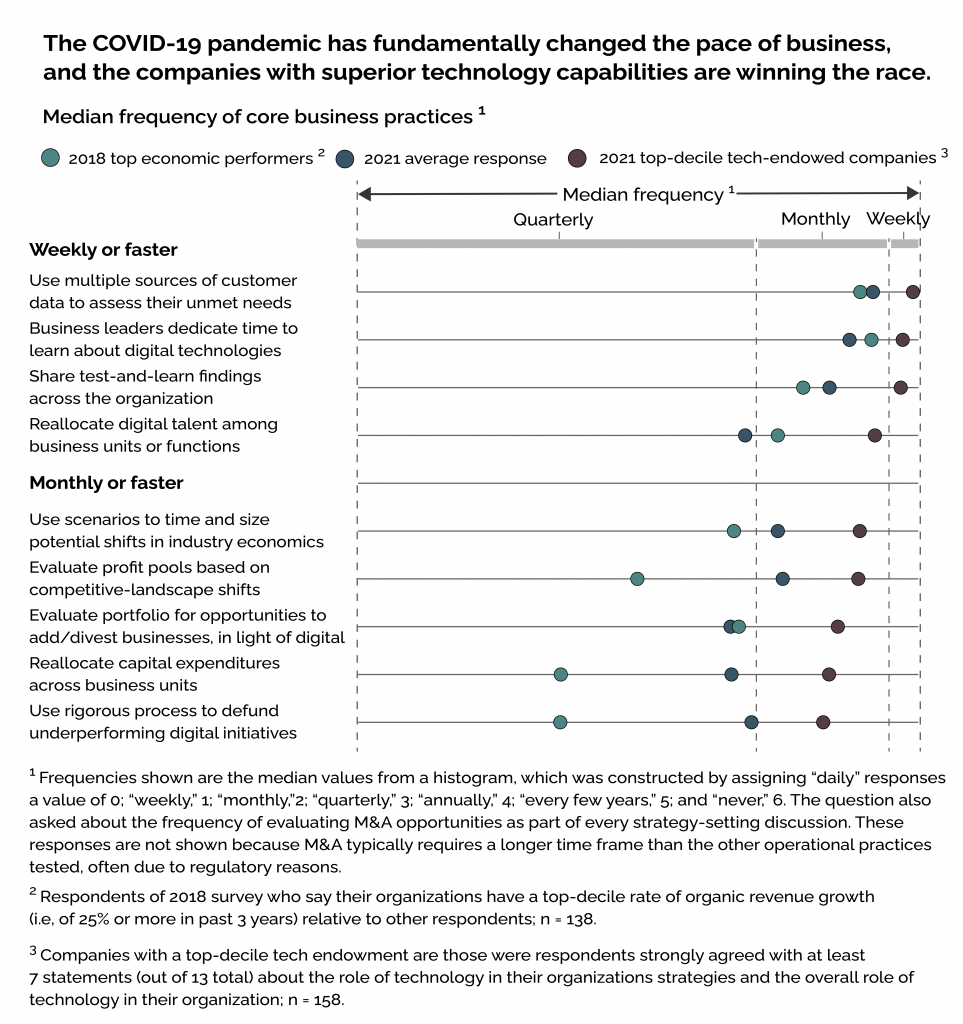Digital transformation is no longer a buzzword; instead, it reshapes how organizations do business, train employees, and interact with customers. The digital transformation took flight at the onset of the global COVID-19 pandemic and continues to take heightened importance as organizations accelerate digital solutions to meet the needs of flexible work schedules, hybrid teams, learning development trends, and how customers receive products or services. The McKinsey Global Survey suggests that the adoption of digital technologies has sped up by three to seven years in a span of months. The results below show this acceleration occurring across key areas of the business model and provide a reason to prepare the workforce for digital transformation.
 Consider digital transformation as a catchall term for describing the implementation of new technologies, talent, and processes to improve business operations and customer satisfaction. Although digital transformation replaces traditional workflows with new technologies, it is not all about digitizing the business; instead, it is about employees and leading them through change. At the core of digital transformation is the organizations’ ability to effectively upskill and motivate employees and managers to adapt to new technologies. So, whether your organization is staying above the curve, lagging, or barely keeping up with digital transformational solutions, the secret for successful implementation is focusing on employee training and strategies that prepare the workforce for the transformation.
Consider digital transformation as a catchall term for describing the implementation of new technologies, talent, and processes to improve business operations and customer satisfaction. Although digital transformation replaces traditional workflows with new technologies, it is not all about digitizing the business; instead, it is about employees and leading them through change. At the core of digital transformation is the organizations’ ability to effectively upskill and motivate employees and managers to adapt to new technologies. So, whether your organization is staying above the curve, lagging, or barely keeping up with digital transformational solutions, the secret for successful implementation is focusing on employee training and strategies that prepare the workforce for the transformation.
This article will explore why digital transformation fails, how to avoid pitfalls, and effective change management strategies to execute the transformation.
Why employees play a pivotal role in your digital transformation
Whether you are implementing a new HR system, customer management system, or a cloud-based solution, the reality is that such software provides frequent incremental releases, and to keep up with ever-changing software, change, and learning leaders will be tasked with creating innovative communications and learning programs that inform employees what the new technology means for their role and responsibilities. McKinsey & Company also estimates that 70% of transformations fail due to lack of support from employees and effective communication from leadership, so it is imperative to engage employees in the transformation from conception through implementation.
Obstacles to digital transformation and how to avoid pitfalls
As previously stated, lack of communication from leadership and the organization is one of the biggest deterrents to digital transformation and is the reason such initiatives fail. To limit communication missteps, Widen Director of Customer Success Michael Shattuck recommends forming a “digital transformation committee” made up of team members from different levels within the business, and I could not agree more. The committee’s purpose is to identify barriers across the company’s culture, technology, and process. The development of the committee will aid in the organization or team-specific communication needed to facilitate the transformation.
In addition to managing communication, missteps consider the following when developing your organization’s transformation strategy.
- Start from the top: Change that starts at the top reflects a committed, invested, and unified leadership. During mergers, research around leadership has found that the leader’s presence, guidance, and support alleviated employee fears, reduced anxiety, and helped employees feel more confident about the transformation.
- Develop a suite of learning resources: One of the most overlooked segments of the office ecosystem when discussing digital transformations is the employees themselves, both new hires and ongoing professionals. If an organization fails to keep up with its employees’ training and development needs, it will fail in its digital transformation efforts. The goal is to make employees active learners in the transformation process. Blended learning solutions such as microlearning, virtual led training, or online webinars are effective ways to train employees on the tools and platforms they will work with daily. Radiant Digital can assess your training needs and develop learning programs that have longevity if you seek to learn solutions that support you during digital transformation initiatives.
- Minimize disruption: Changing existing processes within an organization can be a headache; however, mitigating the effects of those changes on employees is vital. Although leadership may see the introduction of automation into core business functions to save time and money, employees who were previously tasked with these roles may feel replaced, threatened with obsolescence, or lacking direction.
In addition, digital transformation initiatives requiring organizational restructuring may cause employees who are moved to another position to feel indignant, confused or wonder what was wrong with the previous structure. To minimize this disruption and associated resistance among the workforce, the following may be considered:
- Plan for some disruption/resistance and create awareness around the transformation early.
- Fostering a culture that supports change or transformation.
- Empowering champions such as project managers or team leaders to provide clarity and context for changes.
Here at Radiant Digital, we are ready to support your overall digital transformation strategy by guiding you through the key phases of change management. Reach out to our team to learn more about our learning and change solutions.


